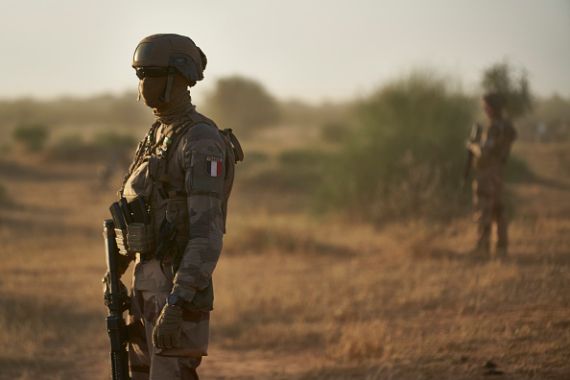Timeline: Nine years of French troops in Mali
The relationship between France and its former colony has soured over the years as armed non-state actors grew bolder.

France and its European allies are pulling their troops out of Mali after the country’s military rule brought in Russian mercenaries and refused to stick to a calendar to hold elections.
Here is a timeline of relations since the French were welcomed almost a decade ago to help stop a takeover by armed non-state actors.
Keep reading
list of 3 itemsMacron expected to announce French withdrawal from Mali
France, European allies announce military withdrawal from Mali
2012
Tuareg forces and rebels allied to Al-Qaeda in the Islamic Maghreb (AQIM) capture the northern two-thirds of Mali.
The hardline fighters quickly sideline the Tuareg, carry out atrocities and destroy mausoleums in the fabled desert city of Timbuktu.
2013
In January, Mali appeals to France for help as the fighters advance southward towards the capital, Bamako.
The former colonial power sends a 1,700-strong force as part of Operation Serval and routs the the fighters with help from neighbouring Chad.
2014
France broadens its operations as violence spreads to Burkina Faso and Niger. Paris deploys 5,100 troops in five Sahel countries, in what becomes known as Operation Barkhane.
Barkhane expands the 1,700-troop deployment in Mali to a broader counterterrorism force in the Sahel. As part of the operation, some 3,000 French troops operate out of Mali, Burkina Faso, Niger and Chad.
2015
In May and June, the Malian government and former Tuareg rebels sign a peace agreement, which is never fully implemented.
Rebel leader Adnan Abu Walid al-Sahraoui pledges allegiance to ISIL (ISIS) in May and forms the Islamic State in the Greater Sahara (ISGS).
Twenty-five people including 16 foreigners are killed in two attacks on a hotel and a restaurant in Bamako in March and November by fighters from al-Mourabitoun, a group led by one-eyed Algerian revolutionary Mokhtar Belmokhtar.
2017
In January, al-Mourabitoun carries out a suicide bombing in a camp in Gao that leaves 77 dead and 120 wounded.
Mali’s main armed groups including al-Mourabitoun merge in March to form Nusrat al-Islam wal Muslimeen (JNIM), an al-Qaeda affiliate under the leadership of Tuareg fighter Iyad Ag-Ghali.
The leaders of five Sahel countries in July agree to create an anti-terror task force called “G5 Sahel” which is backed by France.
2019
French special forces in May rescue two French hostages kidnapped in Benin and held in Burkina Faso. Two French soldiers are killed in the nighttime raid.
Thirteen French soldiers die in November when their helicopters collide in the dark as they hunt for non-state actors, highlighting the human cost of efforts to drive non-state actors out of Mali.
That same month, protesters outside Bamako burn a French flag in anger over attacks in central and northern Mali.
2020
President Ibrahim Boubacar Keita is overthrown by the military in August 2020 after several months of street protests.
An interim government is created.
2021
After the interim government’s civilian leaders remove soldiers from some key posts, coup leader Colonel Assimi Goita stages a second military takeover in May.
Relations with Paris deteriorate rapidly when Goita’s group refuses to hold promised elections.
On June 10, President Emmanuel Macron says the French military presence is being reduced to between 2,500 and 3,000 troops.
Russian mercenaries from the Wagner group reportedly begin deploying in Mali at the end of December to shore up its military leaders. The military-led government denies hiring Wagner.
2022
On January 9, West African bloc ECOWAS imposes an embargo on Mali over the cancelled elections, demanding a return to civilian rule.
Tensions mount and Mali expels the French ambassador on January 31.
The next day, Paris says it is giving itself two weeks to decide whether to keep its troops in Mali. Up to 1,000 Russian mercenaries are now on the ground.
On February 4, thousands of anti-French protesters take to the streets waving Russian flags and burning cardboard cut-outs of French President Emmanuel Macron in celebration of the expulsion.
Two weeks later, Macron announces the withdrawal of troops from Mali, at the EU-AU Summit in Brussels.